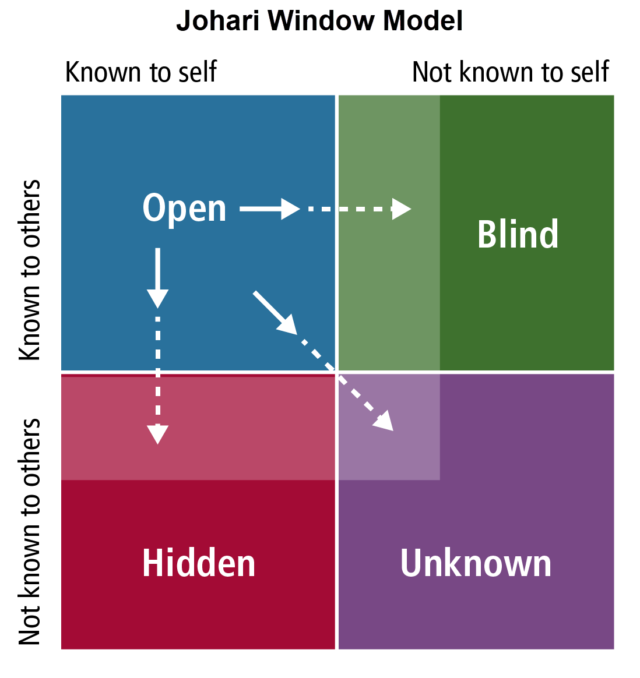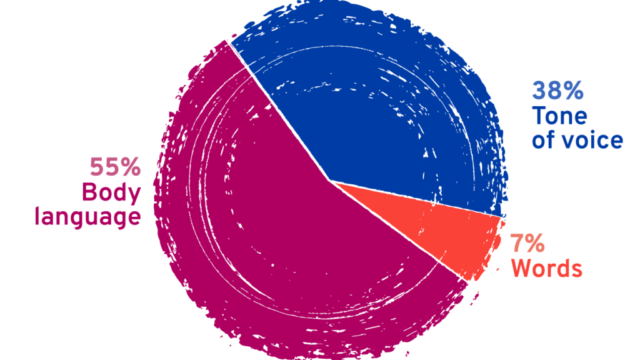Johari Window
The Johari Window is a model for understanding the dynamics of interpersonal communication and self-awareness. It was developed by psychologists Joseph Luft and Harry Ingham in 1955.
The Johari Window consists of a square divided into four quadrants, each representing a different aspect of the self. The first quadrant, known as the "open" or "public" area, represents aspects of the self that are known to oneself and others. The second quadrant, the "blind" area, represents aspects of the self that are not known to oneself but are apparent to others. The third quadrant, the "hidden" or "private" area, represents aspects of the self that are known to oneself but not to others. The fourth quadrant, known as the "unknown" area, represents aspects of the self that are unknown to oneself or others.

The Johari Window is often used for personal development and improving communication and relationships by expanding the open area and reducing the blind, hidden, and unknown areas. This can be achieved through feedback, self-disclosure, and active listening.
PRESENTING THE MODEL BY USING ANALOGY
One way to think of the Johari Window is to imagine it as a house with four rooms. The first room is the open or public room, where everyone is welcome and knows what is happening. The second room is the blind room, where other people can see what is happening, but you cannot. The third room is the hidden or private room, where you keep things to yourself and do not let others in. Finally, the fourth room is the unknown room, where nobody has been, and you are unsure what is inside.
You want to make your house as welcoming as possible to improve your relationships and communication with others. You can do this by opening the doors and windows of the open room to let in more light and air and inviting others to visit and share their perspectives. You can also work to identify and address any blind spots or hidden areas in your house by asking others for feedback and being more honest and open about your thoughts and feelings.
By expanding the open room and reducing the blind, hidden, and unknown areas, you can create a more comfortable and trusting environment for yourself and others. This can lead to better communication, deeper relationships, and greater personal growth and self-awareness.
PRESENTING THE MODEL BY GIVING AN EXAMPLE
Sam is a member of a project team at work. Sam is a bit reserved, tends to keep to themselves, and sometimes struggles to communicate effectively with their team members. Let's see how the Johari Window can be applied to Sam:
Open area: Sam is good at organizing and is a proficient coder. They have shared this information with the team; everyone knows their skills in these areas. This is part of Sam's open area.
Blind area: Sam avoids conflict and may not always speak up when they have concerns or ideas. Other team members may notice this, but Sam may not know it. This is part of Sam's blind area.
Hidden area: Sam struggles with personal issues at home, which sometimes affect their work. They haven't shared this with the team because they feel it's too personal. This is part of Sam's hidden area.
Unknown area: Sam is a great problem solver but has not yet been able to showcase this talent on the current project. This is part of Sam's unknown area.
To improve their communication and collaboration with the team, Sam could expand their open area by sharing more of their thoughts and ideas and asking for feedback from their team members. They could also work on identifying and addressing their blind spots by actively seeking input from others and being more assertive when they have concerns or suggestions.
To expand their hidden area, Sam could consider sharing their personal struggles with a trusted colleague or manager or seeking support from a professional if needed. Finally, to develop their unknown area, Sam could volunteer for more challenging tasks or take on a leadership role within the team, allowing them to showcase their problem-solving skills and potentially open up new opportunities for growth and development.
Downloads
Video
Founder
Related Topics
Johari Window 0 reviews
Login to Write Your ReviewThere are no reviews yet.




